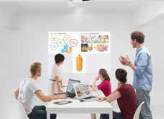Basic HTML Version




www.binfo.co.uk
magazine
08
agenda
In the near future, small base stations in our homes and cars
might be needed to help mobile networks deal with massive
increases in traffic.
This is one of the possibilities being examined by the
Department of Signals and Systems at Chalmers University
of Technology, which is taking part in Metis, an EU-funded
international research project into 5th generation wireless systems.
The Swedish university argues that in coming years, mobile
networks will need to be much denser to cope with greater
use of smartphones and mobile services and a large increase
in the number of industrial, transport and other devices
communicating over mobile networks.
Smartphone subscriptions are expected to increase from 1.2
billion in 2012 to 4.5 billion in 2018.
Associate professor Tommy Svensson said: “We see that
traffic capacity in the long term needs to increase a thousand-
fold to meet this rapid development. Theoretically, we could
provide the capacity by increasing the number of big base
stations, but this option is not economically viable.”
A more affordable solution could be to supplement the
infrastructure with low-power, small base stations positioned
next to lampposts and indoors or in cars, trucks, buses and trains.
Chalmers University of Technology says that such additions
to the mobile network will make data transfer from big base
stations more efficient and reduce the distance to users
resulting in faster data traffic and improved mobile device
battery life. Because small base stations located close to users
enable radio signals to be used more efficiently and transmitted
with less power, they should also reduce exposure to radiation
from mobile communications.
www.chalmers.se
Eighty billion
‘things’ connected to
internet by 2020
By 2020, there will be 80 billion
‘things’ connected to the internet,
IDATE claims in a new report on the
Internet of Things (IoT).
For IDATE, the Internet of Things
includes any item that connects to
the internet to retrieve information
that enhances its intrinsic value. This
includes communicating devices,
machine-to-machine (M2M) devices
and the Internet of Objects (IoO) –
objects that connect to the internet
via intermediate devices such as RFIDs
and 2D barcodes.
According to IDATE, the Internet
of Things comprised 15 billion items
in 2012, up from 4 billion in 2010. By
2020, it is expected to reach 80 billion
items, of which 85% will be IoO, 11%
communicating devices and 4% M2M.
www.idate.org
Meeting room technology a
double-edged sword
Is technology a time-waster or a
time-saver? A new survey of 1,300
business people on both sides of the
Atlantic suggests that the answer
might be a bit of both.
Research by Barco into meeting
culture in the US and Europe,
Obstacles to
effective business
meetings
, shows
that meetings in
Europe are longer
and less effective
than those in
America.
Almost
half (48%)
of European
business leaders
agreed with the statement “we just
seem to meet and meet and never
seem to get any work done”, compared
to 24% of US respondents.While 71%
of business leaders in Europe spend
over a quarter of their week in the
meeting room, the figure in the US is
just 26%.
Moreover, 29% of meetings in the
US last less than 45 minutes compared
to just 11% in the EU.
When asked what it would take to
improve the effectiveness of meetings,
82% cited having the right technology.
The most popular improvements are
having an easy way for presenters
to connect mobile devices to the
meeting room system; easy connection
for seated participants; faster start-
up times;
and wireless
connection to
the projector or
display.
Three
quarters (73%)
of European
managers think it
would be useful
to be able to
share content
from a tablet or smartphone. However,
today only 14% can do so.
On the downside, the UK experience
suggests that greater use of IT increases
support requirements. The UK is the
best-equipped technologically, with
83% of managers using laptops to share
information in meeting rooms, 53% using
tablets and 41% using smartphones. Yet,
IT has to intervene in UK meetings twice
as often as in the rest of Europe.
www.barco.com/meetingroomsurvey
Hue on view
The all-glass Photon Pod on display at
September’s London Design Festival
helped highlight a new four-year study
into the effects of light on health, well-
being and behaviour being conducted
by Oxford University and glass
engineering company Cantifix. Members
of the public were invited to experience
‘life under glass’ and take part in a
series of simulations that measured
levels of alertness or relaxation in
different light settings provided by the
Philips Hue smartphone-controlled
lighting system.
www.philips.com
www.thephotonproject.org
Remote working growing
Professionals who are chained
to their office desk will soon
be in a minority, according to
a poll of 4,000 business people
by workspace provider Regus.
It found that 42% now work
remotely for at least half their
working week, up from 39%
last year. Employers cite greater
productivity, improved staff
retention and lower operating
costs as the main benefits.
In car base stations needed to cope
with mobile traffic

